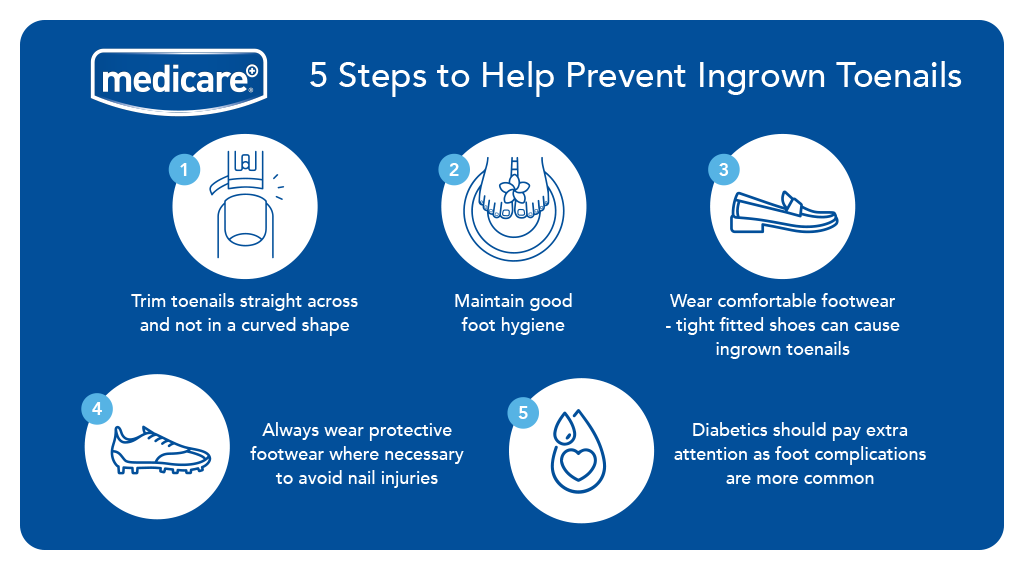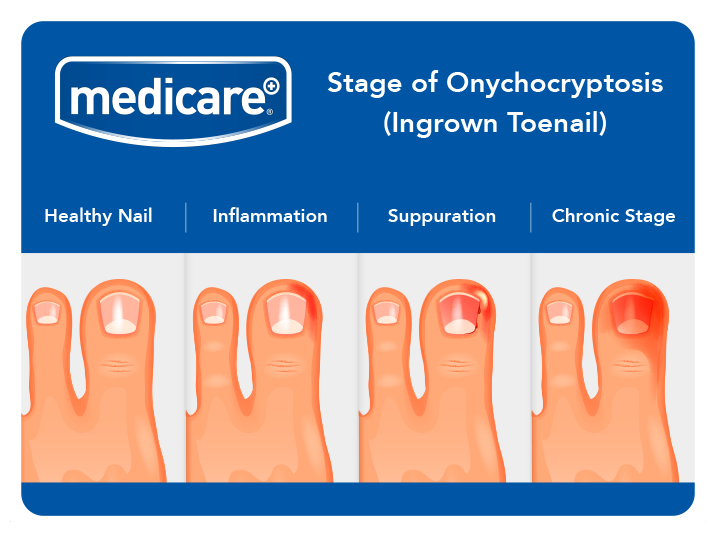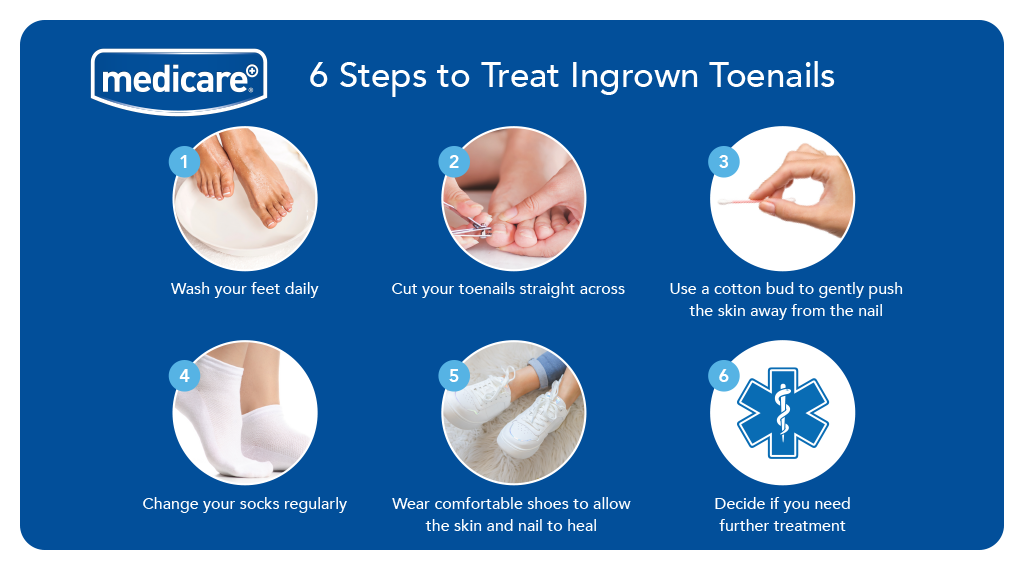Headlines
Remove, Repair, Recover: Ingrown Toenail Prevention & Treatment
23 June 2022

Swelling, pain and tenderness in the skin area around the toes are some common symptoms of ingrown toenails, also known as onychocryptosis.
An ingrown toenail can cause severe discomfort and pain, and this can worsen overtime if left untreated. Luckily you can minimise your chances of getting an ingrown toenail in just a few simple steps.
This is probably one of the most common causes of ingrown toenails. Curved nail edges can cause your nails to grow into your skin. Remember not to cut your nails too short. To achieve a precise cut, use sharp scissors. The Medicare Toenails Scissors is perfect for cutting thick toenails with care.
* Cut your toenails after a hot bath/shower. The water will soften the nails, making them easier to cut and pain free*
Wearing incorrect footwear, socks and tights;
Tight and narrow-fitting footwear places pressure on the skin around the nail.
Having naturally curved nails;
Unfortunately, some people have naturally curved nails which are more likely to pierce into the skin. If you are someone who has this shaped nails, extra vigilance and care must be taken to ensure your nails are trimmed often and in the right direction to prevent the risk of getting ingrown toenails.
Injured toenails:
Nail injuries such as stubbing your toe, kicking something hard, or something dropping on your toe can cause the nail to curve and grow into the soft tissue causing pain and inflammation.
Athletic activities:
Activities that involve putting a lot of pressure on your feet can cause toenail damage and increase your risk of getting ingrown toenails. Such activities include ballet, soccer, kickboxing and football.
Diabetes:
Diabetes causes poor blood flow and can lead to multiple complications including ingrown nails, fungal nails and corns. Click here to read our blog post on fungal nail prevention and treatment.
Poor foot hygiene:
Poor foot hygiene and neglecting your foot health can lead to many foot problems including ingrown toenails. For top tips on foot hygiene and a step-by-step pedicure guide, read our new 'Get Your Feet Summer Ready' blog.


It is important to treat an ingrown toenail as soon as symptoms show. If left untreated, ingrown toenails can lead to infection and can require surgery.
 Seek medical help from your GP/podiatrist if you experience any of the above symptoms or if you have diabetes and think you may have an ingrown toenail.
Seek medical help from your GP/podiatrist if you experience any of the above symptoms or if you have diabetes and think you may have an ingrown toenail.
Resources
Know The Causes:
Cutting toenails in a curved shape rather than straight across:This is probably one of the most common causes of ingrown toenails. Curved nail edges can cause your nails to grow into your skin. Remember not to cut your nails too short. To achieve a precise cut, use sharp scissors. The Medicare Toenails Scissors is perfect for cutting thick toenails with care.
* Cut your toenails after a hot bath/shower. The water will soften the nails, making them easier to cut and pain free*
Wearing incorrect footwear, socks and tights;
Tight and narrow-fitting footwear places pressure on the skin around the nail.
Having naturally curved nails;
Unfortunately, some people have naturally curved nails which are more likely to pierce into the skin. If you are someone who has this shaped nails, extra vigilance and care must be taken to ensure your nails are trimmed often and in the right direction to prevent the risk of getting ingrown toenails.
Injured toenails:
Nail injuries such as stubbing your toe, kicking something hard, or something dropping on your toe can cause the nail to curve and grow into the soft tissue causing pain and inflammation.
Athletic activities:
Activities that involve putting a lot of pressure on your feet can cause toenail damage and increase your risk of getting ingrown toenails. Such activities include ballet, soccer, kickboxing and football.
Diabetes:
Diabetes causes poor blood flow and can lead to multiple complications including ingrown nails, fungal nails and corns. Click here to read our blog post on fungal nail prevention and treatment.
Poor foot hygiene:
Poor foot hygiene and neglecting your foot health can lead to many foot problems including ingrown toenails. For top tips on foot hygiene and a step-by-step pedicure guide, read our new 'Get Your Feet Summer Ready' blog.

The Stages of Ingrown Toenails:
Ingrown toenail symptoms are often hard to ignore and usually affect the big toe on one or both feet.- Stage One: Inflammation. At this stage, the end of the toe is red with some mild swelling. It may feel painful to touch but holds no pus. This is the mildest stage of an ingrown nail, and it is most treatable at this stage.
- Stage Two: Suppuration. The toe has gotten significantly sorer with more apparent swelling and visible inflammation. There may be pus surrounding the area at this stage and infection may be present.
- Stage Three: Chronic Stage. This is the most painful stage where the toe needs further care and home remedies will not suffice. Fever may accompany other symptoms including intense pain and swelling of the toe. Infection is present and there is pus and fluid coming out of the surrounding skin.

It is important to treat an ingrown toenail as soon as symptoms show. If left untreated, ingrown toenails can lead to infection and can require surgery.
 Seek medical help from your GP/podiatrist if you experience any of the above symptoms or if you have diabetes and think you may have an ingrown toenail.
Seek medical help from your GP/podiatrist if you experience any of the above symptoms or if you have diabetes and think you may have an ingrown toenail.Resources
- https://www2.hse.ie/conditions/ingrown-toenail/
- https://www.healthline.com/health/ingrown-toenail#treatment
- https://dermnetnz.org/topics/ingrown-toenail
